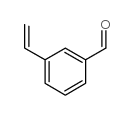| Structure | Name/CAS No. | Articles |
|---|---|---|
 |
3-VINYLBENZALDEHYDE
CAS:19955-99-8 |
R P Garrod, L G Harris, W C E Schofield, J McGettrick, L J Ward, D O H Teare, J P S Badyal
Index: Langmuir 23(2) , 689-93, (2007)
Full Text: HTML
A simple two-step plasmachemical methodology is outlined for the fabrication of microcondensor surfaces. This comprises the creation of a superhydrophobic background followed by pulsed plasma deposition of a hydrophilic polymer array. Microcondensation efficiency has been explored in terms of the chemical nature of the hydrophilic pixels and their dimensions. These results are compared to the hydrophilic-hydrophobic pattern present on the Stenocara beetle's back, which is used by the insect to collect water in the desert. Potential applications include fog harvesting, microfluidics, and biomolecule immobilization.
| Structure | Name/CAS No. | Molecular Formula | Articles |
|---|---|---|---|
 |
3-VINYLBENZALDEHYDE
CAS:19955-99-8 |
C9H8O |
|
Chemoselective synthesis of substituted imines, secondary am...
2009-08-17 [Chemistry 15(33) , 8196-203, (2009)] |
|
Protection and polymerization of functional monomers. 15. An...
[Macromolecules 24(7) , 1449-1454, (1991)] |
|
A novel de-cross-linking system from cross-linked polymer to...
[Macromolecules 41(23) , 8995-8999, (2008)] |
|
New benzylidene oxazolone derived polymeric photoswitches fo...
[Polym. Chem. 5(22) , 6426-6430, (2014)] |
Home | MSDS/SDS Database Search | Journals | Product Classification | Biologically Active Compounds | Selling Leads | About Us | Disclaimer
Copyright © 2024 ChemSrc All Rights Reserved